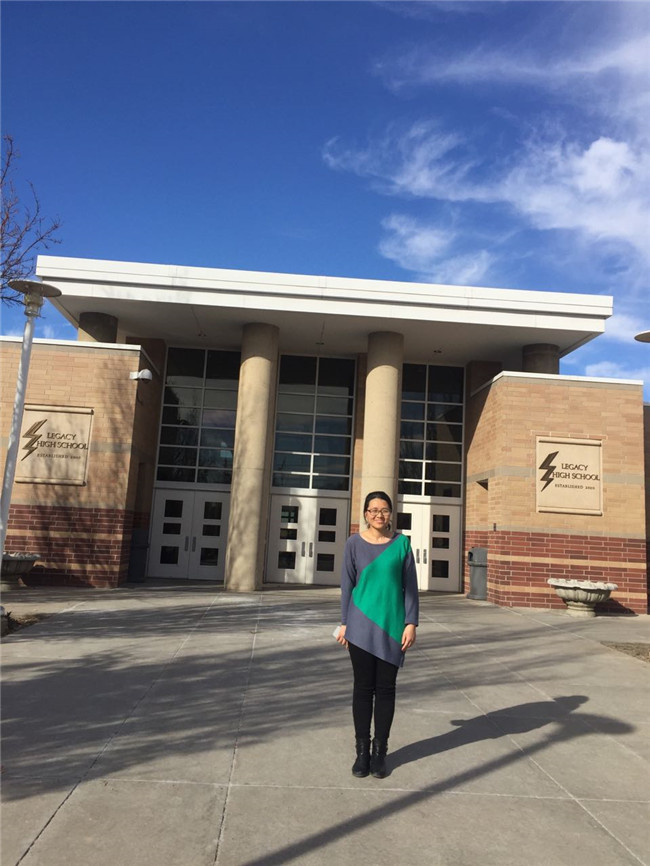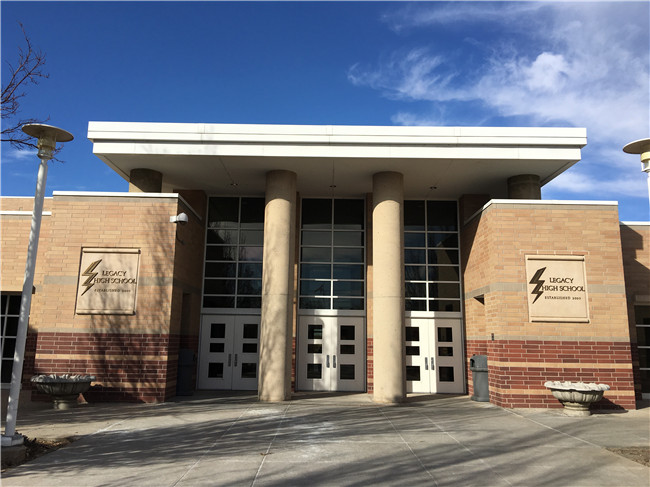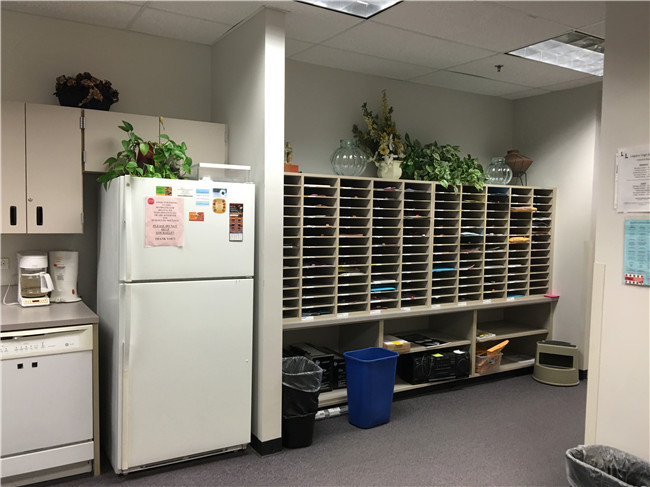【海外研修日记】美国高中一日见闻录

在我们的黄教授帮助下,我和另外一个同事有幸参观了美国丹佛当地的一所口碑不错的高中——传统高中,这所高中到底怎么出色呢?一进门,各种各样的奖杯和荣誉展示就告诉我们,这所学校已经连续几年获得美国最佳高中的奖杯。

在办公室的前台,已经有两名学生“导游”在等待我们,她们都来自学校的“学生会”(student government)。她们陪同我们一边走一边介绍自己和学校,如果看见我们沉默了,两个学生就不停问我们需要知道什么,想要知道什么。参观一共分八个环节,后面四个环节由另外两个学生带领我们去不同的教室,整个过程让参观者感到舒服和温暖。
在双方交流的过程中,我们了解到,她们晚上作业量取决于课程和教那门课程的老师,她们通常很晚才睡。
第一节和第二节课是社会学习,他们叫world studies,两个老师共用一个大教室,但是这个大教室中间有帘子,需要的时候可以对空间进行分隔。65名学生的座位是固定的,学生进班级后有秩序地拿椅子然后回到自己的座位。
正式上课了,不同于我之前想象的,老师在整个课堂上提的问题看起来比较简单,但却都是具有层次、文化角度、历史角度检测学生水平的好问题。
在讨论问题时段,是采取小组自由组合的方式,学生把桌子一拉,围成一个圈就讨论起来,当然也会有不主动参与课堂讨论的学生,老师会在班级巡视,鼓励他们参与活动。两个老师各有一节主场一节配合。课间,老师还带着学生们做了类似于中国的“鼻子鼻子眼睛”的小游戏,让学生活动一下身体。
两节课结束后,校长还特别给我们开了一个小小的会,介绍了一下学校和老师的情况,不停地问我们需要了解什么并且可以给我们提供帮助。
第三节和第四节是科学课,学习计算机和物理。计算机课上,学生学习的是我们初中曾经学过的“反射与折射”,他们的老师鼓励学生在计算机上不停地实验,让学生通过实验把数据填写在问题里,计算机模拟的精确性使学生的认知更加精准。
物理课是一节分享课,学生以小组的形式上前分享自己小组的主题,他们分工合作,自己制作PPT,里面有学生找的视频,整个分享过程大概15分钟左右。让我们惊喜的有两点:一是分享的过程中有其他老师和学生需要进来,但这组学生没有结束,这个物理老师不允许进;二是小组分享完,他请我们和学生一起到教室外面做点评,从学生的阐述到PPT的制作,分享的效果和各个方面的点评,既照顾了学生的心理,让其感受到老师充分的尊重,又让学生得到恰当的点评,了解自己需要改进的地方。

午饭时间,我们看到了老师的休息间,整洁明亮,摆放有序,我们开玩笑说,“看一所学校是不是好学校,只要看他们的教师休息室或茶歇间就知道了。”
第五节和第六节课是西班牙语和数学。西班牙语老师整节课更加突出学生的说,语法涉及很少。在数学课上,数学老师则根据一个证明等式,给学生提供了8种证明的方法,由于是学生的证明,这里面有正确的,有不完整的,老师在讲解的过程中,会告诉学生各种证明的关键点。另外,在数学课上,我们还遇到了一位为聋哑学生服务的特别老师,全程为这名学生翻译老师和学生说的话,其间还有互动,我仔细观察了这名学生,感觉他非常开心。
所有听课环节结束后,我们还参加了这所高中的教师教研会,一起讨论和研究了学生的作业。老师们很认真,根据大纲要求对学生的作业进行评分,最后是关于学生调查问卷的讨论及下周的安排。整个过程氛围很活跃。由于是历史老师的教研会,在会上他们还特别郑重地问了我几个关于中国的问题,而且说,如果我不想回答,可以选择不回答。
在传统高中的一天,我们要特别感谢接待我们的校长和校长助理,感谢她们精心的安排。我们有几点特别深的感触:

美国学生在很努力地学习我们的历史。
高中学生都很努力、辛苦,纪律很好,完全不像美剧里那样,当然也不像一些朋友圈转发的文章那样,这个要看学生所选课程和课程老师。当然会有地区差异和个体差异。
小组活动和小组作业确实很多,在我们所观摩的六节课中均有涉及。说明不是偶然现象。
中国的基础教育确实做得很好。
要学习我们不擅长的,或者需要提高和改进的方面;要真正地帮助学生,尊重学生。正如每个教育者所追求的都是一样的,教育是帮助个体认识自己,成长自己,最终变成最好的自己。
One Day in an American High School
With the help of Professor Huang, we had an opportunity to have a look atLegacy High School, which is a famous and traditional high school in Denver, Colorado. Why is this school so famous, you ask? When I entered the school, I found out. This school has won many prizes and has gained recognition as one of the “Best High Schools” by U.S News and World Report.
When we arrived at the front desk of the school, there were two students “guides” waiting for us. They represented the student government and accompanied us on a tour of their school, asking if we had any questions and telling us interesting facts and information along the way. Our tour included eight parts in total. We were also shown into the different kinds of classrooms midway through the tour and were received in a warm and comfortable manner.
Throughout the communication with them, we learned that these two students went to bed very late at night because they usually had a lot of assignments to do. The amount of homework varies according to different courses and teachers.
The first and second classes were world social studies classes with two teachers sharing the same classroom of 65 students. If the teachers needed separate space, then the room could be divided by a hanging curtain in the middle.When students enter the classroom, they go to their own permanent seats one by one.
Teachers used a different method of questioning which looked simple, but tested students’ different levels of thinking from both an historical and cultural view.
During discussion time, students would put their tables together in a circle so they could join groups to discuss thetopics and exchange ideas with each other. Of course, there were some students who were not willing to participate in the discussion, so the teachers had to monitor the groups and encourage them to take part. The two teachers worked together to keep the students engaged during class; and, during the break, they also played games with the students, such as “Simon says”(similar to the Chinese traditional game “nose nose eyes”).
After those two classes, the principal of the high school held a conference with us, introducing the school and teachers, and she asked us if there was anything we wanted to know that she could help us with.
The third and fourth classes were science classes involving “reflection and refraction”, which we learned in our middle school. The students were required to do experiments on computers and to complete a survey based on their results. With the help of the computer simulations, students were able to achieve a higher level of precision.
Physics class was a team-working class with the students sharing and cooperating in groups in order to make PowerPoint presentations (PPTs), including videos, for introducing their group topics. The actual process of presentation took 15 minutes. We were surprised by two points: (1) the teacher didn’t allow other students or teachers to come into the classroom while students were giving their presentations; and (2) the teacher invited students to go outside and gave some advice and suggestions on how to effectively share and present the PPT information to the others. In this way, students and the teacher interacted in a respectful manner and shared how to do better and improve presentation skills.
We visited the teachers’ lunchroomtoo. It was clean and bright, the floors were well-scrubbed, and everything was in good order. We joked that, if you want to know whether a school is a good one or not, just look at the teachers’ lunchroom or restroom.
The fifth class was Spanish, and the Spanish teacher emphasized speaking more and having less grammar during the class.Then we moved to observe the sixth class which was math class. The teacher provided eight ways to prove a formula and then students tried to solve the problem using one of those methods.Of course, there were some mistakes and unfinished works, so the teacher explained the process of proving the formula and the key points. There was also a ‘special needs’ student in the class who was deaf-and-dumb, so there was a push-in teaching specialist in the classroom. She translated all the information presented in that class to the student throughout the entire class time, even when the student interacted with the math teacher. From my observation, the student seemed very happy.
When all observations of classes were finished, we took part in a teaching and research group meeting. We discussed and exchanged opinions about students’ assignments and how teachers will use rubrics to grade the assignments. The last items discussed were the students’ survey and the plans for the next week. The whole discussion and exchange was very active and inspiring. Some of the participants were history teachers, so they were interested in hearing some Chinese history. During the workshop session, they asked me some optional questions about China and I could choose to answer or not.
We felt so grateful to have been given this opportunity, and we thanked the principal and her assistant for their thoughtful arrangements.
The feelings about this visit we would like to share are:
1.American students work hard to study Chinese history.
2.Most students in this high school are making efforts to learn and they have discipline in their learning. It is not like what we have seen in the plays, movies and posted articles from WeChat. Of course, there are regional differences and individual differences, but the students and teachers make the academic environment what it is.
3.I observed that students join in a lot of group work both in and out of the classroom and believethis is not just an exception of this single school.
4.China’s basic education is really good.
We aim to learn what we are not good at as well as what we perceive we need to improve in. We aim to help students and to respect them. All educators try to help individuals develop themselves so they can grow up to be the best they possibly can become.
文|牛艳(北科罗拉多大学)


